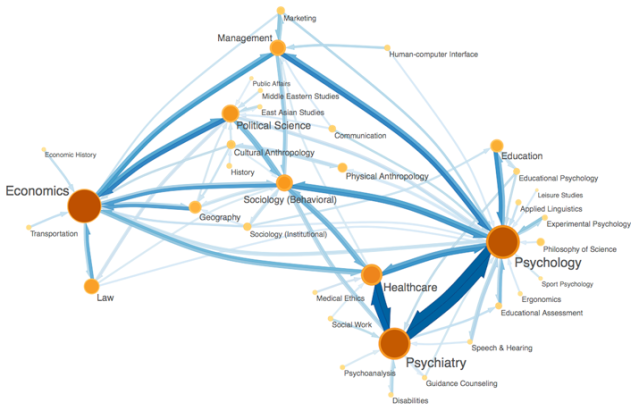Author: Ana Pérez-Escoda Translation: Erika-Lucia Gonzalez-Carrion
In the current panorama of metrics that measure our scientific production, traditional metrics and alternatives, it becomes confusing, and sometimes, oppressive to interpret or to know the indexes and indicators that measure and justify the value of academic production. It is for that reason that today we devote this post to the indexes of valuation of scientific journals Eigenfactor.
In 2007 two academics of Washington University, Jevin West and Carl Bergstrom, created an alternative way of evaluating the impact of scientific journals: EigenfactorTM Metrics. The Eigenfactor punctuation values the relative importance of a publication for the scientific community, in a way that the sum of the punctuations of all the magazines sums 100; however, this punctuation is influenced by the size of a publication measured by the number of annual published articles (a magazine that duplicates the number of articles that publishes, duplicates in the same way its Eigenfactor punctuation).

The Eigenfactor punctuation offers two different indexes:
- Eigenfactor Score. Based on the number of times that the published articles in the last five years have been cited in the present year. The essential difference with the other, more than the years, is:
- Takes into account cites both of sciences as well as social sciences.
- Eliminates the self cites (the cites within the same journal).
- It gives more value to those cites that appear in the most important journals.
- Article Influence Score: It is obtained since the Eigenfactor, measuring the influence of the articles of a journal in the next five years. It is obtained by dividing the Eigenfactor among the quantity of published articles.
Both indexes are included among the presentations of the ISI Reuters (JCR), with the idea of not considering only the Impact Factor, as the unique pattern of measuring the scientific quality, because of that we find us included in the repertoire of metrics that the ISI Web of Science offers.

The idea that moves this measuring is that it does not matter how much a journal is cited, but who do it and how do they do it. This way, it does not have the same value a self cite (within the own journal) or citing in a journal without impact than a citation in a most cited of the world journal. In the practice this differentiation is obtained with the creation of networks of relation of disciplines through links, the journals with most links obtain greater value and that value is measured towards the cites that emit given that identifies if a journal has greater or less weight in the network. It is in conclusion a network indicator that outlines a map of relations among disciplines that adds meaningful information complementing the IF of the journal.

Bergstrom C. (2007). Eigenfactor: Measuring the value and prestige of academic journals. C&RL News, May 2007, 314-316. Available on http://octavia.zoology.washington.edu/publications/Bergstrom07.pdfen: http://www.ala.org/ala/mgrps/divs/acrl/publications/crlnews/2007/may/eigenfactor.cfm
